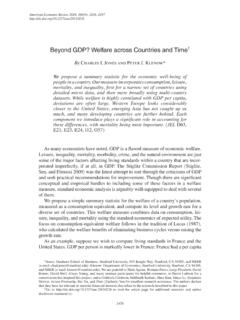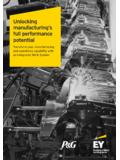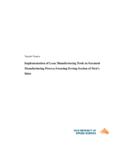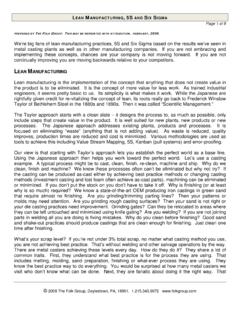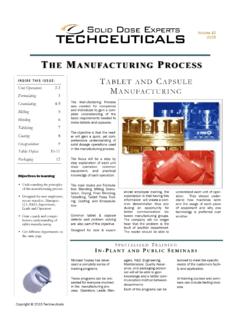Transcription of THE QUARTERLY JOURNAL OF ECONOMICS
1 THEQUARTERLY JOURNALOF ECONOMICSVol. CXXIVN ovember 2009 Issue 4 MISALLOCATION AND manufacturing TFPIN CHINA AND INDIA CHANG-TAIHSIEH ANDPETERJ. KLENOWR esource misallocation can lower aggregate total factor productivity (TFP). Weuse microdata on manufacturing establishments to quantify the potential extentof misallocation in China and India versus the United States. We measure sizablegaps in marginal products of labor and capital across plants within narrowlydefined industries in China and India compared with the United States. Whencapital and labor are hypothetically reallocated to equalize marginal products tothe extent observed in the United States, we calculate manufacturing TFP gainsof 30% 50% in China and 40% 60% in INTRODUCTIONL arge differences in output per worker between rich andpoor countries have been attributed, in no small part, to differ-ences in total factor productivity (TFP).1 The natural questionthen is: What are the underlying causes of these large TFP dif-ferences?
2 Research on this question has largely focused on dif-ferences in technology within representative firms. For example,Howitt (2000) and Klenow and Rodr guez-Clare (2005) show howlarge TFP differences can emerge in a world with slow technology We are indebted to Ryoji Hiraguchi and Romans Pancs for phenomenalresearch assistance, and to seminar participants, referees, and the editors forcomments. We gratefully acknowledge the financial support of the Kauffman Foun-dation. Hsieh thanks the Alfred P. Sloan Foundation and Klenow thanks SIEPRfor financial support. The research in this paper on manufacturing was con-ducted while the authors were Special Sworn Status researchers of the CensusBureau at the California Census Research Data Center at UC Berkeley. Researchresults and conclusions expressed are those of the authors and do not necessarilyreflect the views of the Census Bureau. This paper has been screened to ensurethat no confidential data are See Caselli (2005), Hall and Jones (1999), and Klenow and Rodr guez-Clare(1997).
3 C 2009 by the President and Fellows of Harvard College and the Massachusetts Institute QUARTERLY JOURNAL of ECONOMICS , November 200914031404 QUARTERLY JOURNAL OF ECONOMICS diffusion from advanced countries to other countries. These aremodels ofwithin-firm inefficiency, with the inefficiency varyingacross recent paper by Restuccia and Rogerson (2008) takes a dif-ferent approach. Instead of focusing on the efficiency of a repre-sentative firm, they suggest that misallocation of resources acrossfirms can have important effects on aggregate TFP. For example,imagine an economy with two firms that have identical technolo-gies but in which the firm with political connections benefits fromsubsidized credit (say from a state-owned bank) and the other firm(without political connections) can only borrow at high interestrates from informal financial markets. Assuming that both firmsequate the marginal product of capital with the interest rate, themarginal product of capital of the firm with access to subsidizedcredit will be lower than the marginal product of the firm that onlyhas access to informal financial markets.
4 This is a clear case ofcapital misallocation: aggregate output would be higher if capitalwas reallocated from the firm with a low marginal product to thefirm with a high marginal product. The misallocation of capitalresults in low aggregate output per worker and institutions and policies can potentially result in re-source misallocation. For example, the McKinsey Global Institute(1998) argues that a key factor behind low productivity in Brazil sretail sector is labor-market regulations driving up the cost of la-bor for supermarkets relative to informal retailers. Despite theirlow productivity, the lower cost of labor faced by informal-sectorretailers makes it possible for them to command a large share ofthe Brazilian retail sector. Lewis (2004) describes many similarcase studies from the McKinsey Global goal in this paper is to provide quantitative evidence onthe potential impact of resource misallocation on aggregate use a standard model of monopolistic competition with het-erogeneous firms, essentially Melitz (2003) without internationaltrade, to show how distortions that drive wedges between themarginal products of capital and labor across firms will lower ag-gregate key result we exploit is thatrevenueproductivity(the product of physical productivity and a firm s output price)should be equated across firms in the absence of distortions.
5 Tothe extent revenue productivity differs across firms, we can use itto recover a measure of firm-level In terms of the resulting size distribution, the model is a cousin to theLucas (1978) span-of-control AND TFP IN CHINA AND INDIA1405We use this framework to measure the contribution of re-source misallocation to aggregate manufacturing productivity inChina and India versus the United States. China and India areof particular interest not only because of their size and rela-tive poverty, but because they have carried out reforms that mayhave contributed to their rapid growth in recent useplant-level data from the Chinese Industrial Survey (1998 2005),the Indian Annual Survey of Industries (ASI; 1987 1994), and Census of manufacturing (1977, 1982, 1987, 1992, and 1997)to measure dispersion in the marginal products of capital andlabor within individual four-digit manufacturing sectors in eachcountry. We then measure how much aggregate manufacturingoutput in China and India could increase if capital and labor werereallocated to equalize marginal products across plants withineach four-digit sectorto the extent observed in the United United States is a critical benchmark for us, because theremay be measurement error and factors omitted from the model(such as adjustment costs and markup variation) that generategaps in marginal products even in a comparatively undistortedcountry such as the United find that moving to efficiency would increase TFPby 30% 50% in China and 40% 60% in India.
6 The output gainswould be roughly twice as large if capital accumulated in re-sponse to aggregate TFP gains. We find that deteriorating alloca-tive efficiency may have shaved 2% off Indian manufacturing TFPgrowth from 1987 to 1994, whereas China may have boosted itsTFP 2% per year over 1998 2005 by winnowing its distortions. Inboth India and China, larger plants within industries appear tohave higher marginal products, suggesting they should expand atthe expense of smaller plants. The pattern is much weaker in theUnited Restuccia and Rogerson (2008) is the closest prede-cessor to our investigation in model and method, there are addition to Restuccia and Rogerson, we build on three3. For discussion of Chinese reforms, see Young (2000, 2003) andTheEconomist(2006b). For Indian reforms, see Kochar et al. (2006),The Economist(2006a), and Aghion et al. (2008). Dobson and Kashyap (2006), Farrell and Lund(2006), Allen et al. (2007), and Dollar and Wei (2007) discuss how capital continuesto be misallocated in China and A number of other authors have focused on specific mechanisms that couldresult in resource misallocation.
7 Hopenhayn and Rogerson (1993) studied the im-pact of labor market regulations on allocative efficiency; Lagos (2006) is a recenteffort in this vein. Caselli and Gennaioli (2003) and Buera and Shin (2008) modelinefficiencies in the allocation of capital to managerial talent, while Guner, Ven-tura, and Xu (2008) model misallocation due to size restrictions. Parente and1406 QUARTERLY JOURNAL OF ECONOMICS papers in particular. First, we follow the lead of Chari, Kehoe,and McGrattan (2007) in inferring distortions from the residu-als in first-order conditions. Second, the distinction between afirm s physical productivity and its revenue productivity, high-lighted by Foster, Haltiwanger, and Syverson (2008), is centralto our estimates of resource misallocation. Third, Banerjee andDuflo (2005) emphasize the importance of resource misallocationin understanding aggregate TFP differences across countries, andpresent suggestive evidence that gaps in marginal products of cap-ital in India could play a large role in India s low manufacturingTFP relative to that of the United rest of the paper proceeds as follows.
8 We sketch a modelof monopolistic competition with heterogeneous firms to show howthe misallocation of capital and labor can lower aggregate then take this model to the Chinese, Indian, and plantdata to try to quantify the drag on productivity in China and Indiadue to misallocation in manufacturing . We lay out the model inSection II, describe the data sets in Section III, and present po-tential gains from better allocation in Section IV. In Section V wetry to assess whether greater measurement error in China andIndia could explain away our results. In Section VI we make afirst pass at relating observable policies to allocative efficiency inChina and India. In Section VII we explore alternative explana-tions besides policy distortions and measurement error. We offersome conclusions in Section MISALLOCATION ANDTFPThis section sketches a standard model of monopolistic com-petition with heterogeneous firms to illustrate the effect of re-source misallocation on aggregate productivity.
9 In addition todiffering in their efficiency levels (as in Melitz [2003]), we assumethat firms potentially face different output and capital assume there is a single final goodYproduced by a repre-sentative firm in a perfectly competitive final output market. Thisfirm combines the outputYsofSmanufacturing industries usingPrescott (2000) theorize that low-TFP countries are ones in which vested interestsblock firms from introducing better See Bergoeing et al. (2002), Galindo, Schiantarelli, and Weiss (2007), Alfaro,Charlton, and Kanczuk (2008), and Bartelsman, Haltiwanger, and Scarpetta(2008) for related empirical evidence in other AND TFP IN CHINA AND INDIA1407a Cobb-Douglas production technology:(1)Y=S s=1Y ss,whereS s=1 s= minimization implies(2)PsYs= ,Psrefers to the price of industry outputYSandP Ss=1(Ps/ s) srepresents the price of the final good (the final goodis our numeraire, and soP=1). Industry outputYsis itself a CESaggregate ofMsdifferentiated products:(3)Ys= Ms i=1Y 1 si production function for each differentiated product is givenby a Cobb-Douglas function of firm TFP, capital, and labor:(4)Ysi=AsiK ssiL1 that capital and labor shares are allowed to differ acrossindustries (but not across firms within an industry).
10 6 Because there are two factors of production, we can sepa-rately identify distortions that affect both capital and labor fromdistortions that change the marginal product of one of the factorsrelative to the other factor of production. We denote distortionsthat increase the marginal products of capitalandlabor by thesame proportion as an output distortion Y. For example, Ywouldbe high for firms that face government restrictions on size or hightransportation costs, and low in firms that benefit from publicoutput subsidies. In turn, we denote distortions that raise themarginal product of capital relative to labor as the capital distor-tion K. For example, Kwould be high for firms that do not haveaccess to credit, but low for firms with access to cheap credit (bybusiness groups or state-owned banks).Profits are given by(5) si=(1 Ysi)PsiYsi wLsi (1+ Ksi) In Section VII ( Alternative Explanations ), we relax this assumption byreplacing the plant-specific capital distortion with plant-specific factor JOURNAL OF ECONOMICSNote that we assume all firms face the same wage, an issue towhich we return later.

